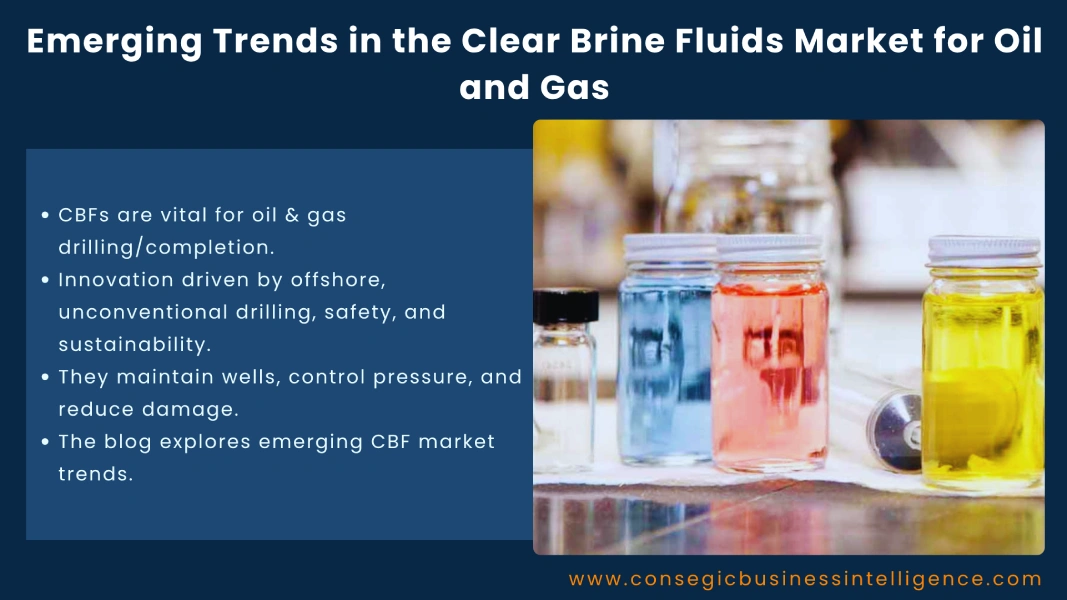Emerging Trends in the Clear Brine Fluids Market for Oil and Gas
Clear brine fluids (CBFs) are the fluids that have been used for a long time as the most important components for drilling and completion operations in the oil and gas industry. They are specially formulated, high-density solutions that maintain the wellbore in good condition, help to control the pressures in the formation, and reduce the damage of the reservoir during complicated operations like workovers, well completions, and sidetracking. The world-wide CBF market in 2025 is experiencing a burst of innovation and a strategic evolution that is fueled by the increase in offshore exploration, unconventional drilling activity, and a renewed focus on safety and sustainability in the industry.
This write-up is intended to be an in-depth search of major trends that are emerging in the clear brine fluids market as well as the ways in which oilfield service companies are responding to the changing operational challenges and regulatory frameworks.

Shift Toward Environmentally Friendly Formulations
The main highlight of 2025 is the industry's direction towards environmentally compliant and biodegradable clear brine fluids. Traditional halide-based brines such as calcium chloride, calcium bromide, and zinc bromide consist of the best density control but environmental safety may still be in question as such brines are toxic and may lead to water pollution, resulting in a disposal problem.
In order to still be compliant with the new environmental rules and at the same time not inhibit their performance, companies will focus on the development of environmentally sustainable products such as potassium formate, sodium formate, and organic salt-based fluids which will be less toxic to the aquatic environment and have a better environmental profile besides being bio-made and hence biodegradable.
Fluid recyclability and post-use treatment procedures are likewise improved. These new formulations take into account multiple reuse cycles with the least possible degradation in performance, thus not only reducing waste generation but also the total cost of ownership.
Deepwater and High-Pressure Wells Customization
The nature of the drilling process is such that it must constantly evolve to explore greater depths, going further into the ocean's depths and venturing into HPHT environments. At this stage, the need for expert brine solutions is undoubtedly the utmost. Typical brine fluids generally lack the bearer of thermal and pressure challenges they face at such deep waters to keep them cool and stable, so the stability of the fluids comes out as the most important factor.
Oilfield service providers are tackling this issue by creating thermally stable brine that has better rheology and corrosion inhibition properties. At the moment, advanced additives are employed to keep ionic balance and prevent scale deposition or clay swelling not only at high temperatures above 350°F but even at high pressure which is beyond 20,000 psi.
In the year 2025, computer codes and AI-powered fluid simulators are utilized for the pretreatment of brine compositions that are in alignment with the reservoir conditions, thus assisting in the decrease of operational risks and fluid failure rates in critical wells.
The digital revolution has already transformed the brine fluids sector. The most recent pattern is the combination of clear brine fluid systems with well monitoring platforms available in real time and sensors compatible with the IoT. These devices give uninterrupted data on the fluid properties like density and pH, salinity, and contamination levels at the time of the operation.
Thus, the operators can dynamically change the fluid formulations and tackle the issues, such as emulsion formation, plugging, or corrosion, without going too far. Besides, the dashboards of brine fluid management can be connected to the cloud, and such decision-making can now take place in one place with historical data analytics to assist.
Brine system digital twins are nowadays part of fluid lifecycle management and they aid operators in performing the tasks of forecasting performance degradation, optimizing logistics, and reducing waste. These digital twins also contribute to both improved operational reliability and compliance with environmental reporting standards.
Regional Growth and Strategic Supply Chain Diversification
Geopolitical shifts and supply chain disruptions in recent years have exposed the vulnerabilities in global chemical sourcing. To meet this challenge, the CBF market is witnessing a trend towards regional localization of production and supply.
Middle Eastern countries such as Saudi Arabia and the UAE are leading the way by establishing local brine manufacturing facilities that will allow them to not only rely less on imports but also to be able to tap their shale and offshore exploration sectors. North American operators are also joining forces with domestic chemical producers in order to have a reliable supply of fluids made from calcium and bromide.
Modular blending units that are located either at the rig site or near-field bases are further going to help in shortening lead times. They also play a crucial role in the just-in-time delivery of customized brine blends, especially in remote offshore locations.
As more wells are drilled in sensitive or unconventional formations, brine fluids that are compatible with the mineralogy of the formation and with the materials used for completion become very important. A fluid that is not compatible with the formation can lead to formation damage, decrease the permeability of the formation, or cause unwanted reactions such as the creation of precipitates and scaling due to the reaction.
In order to solve this problem, the year 2025 is when more and more engineered brine systems will be introduced and those systems will be tested for chemical compatibility with reservoir rock, production tubing, and downhole equipment. Few of the now available preparations even include additives that are customized for a specific job, for example, they can be used to stop the formation fins from moving, they can be the source of microbial growth, and/or they can be the ones that keep emulsions in a mixed fluid environment.
As a part of making a plan for the job beforehand, models of the core flood and interaction of the fluid rock are tools that are used for compatibility testing. These tests might help in choosing the best brine blend for a particular wellbore situation.
Conclusion
The clear brine fluids market for oil and gas is visibly changing into an entirely new market in the year 2025. Following the advent of demanding deepwater operations, the increasing environmental scrutiny, and the rapid digitization of well services, the CBFs have greatly evolved. Though they started as basic chemical solutions, today they are engineered, data-enabled, and sustainability-oriented assets.
Organizations that recognize this change and put their money into environmentally friendly products, smart fluid systems, and integrated supply chains will be in a stronger position to fulfill the performance, price, and regulatory requirements of future drilling and completion ventures.
